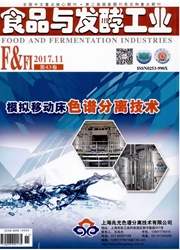

 中文摘要:
中文摘要:
采用自养、异养和混合培养3种营养方式对普通小球藻进行了培养,分析了3种培养方式下小球藻的生长曲线、比生长速率和产率、培养基中pH和葡萄糖的变化,测定了藻细胞的光合色素、蛋白质和油脂含量及其产率。结果表明:混合营养条件下小球藻的比生长速率为自养的4.25—4.43倍、异养的0.78—1.00倍,产率为自养的5.79~6.27倍、异养的1.11—1.31倍;混合营养条件下,单位体积小球藻培养液中总叶绿素、蛋白质和油脂的产率分别为3.62mg/(L·d)、53.41mg/(L·d)和44.65mg/(L·d),均高于自养和异养培养。研究认为,混合营养方式更加符合微藻生长的实际环境,是高密度、高含量活性物质培养微藻的理想方式,具有潜在的应用价值。
 英文摘要:
英文摘要:
The growth curves, specific growth rates and productivities of Chlorella vulgaris were analyzed under autotrophic, heterotrophic and mixotrophic cultivation, as well as the changes of pH values and glucose consumption in medium, the contents and productivities of photosynthetic pigment, protein and lipid were investigated. The results indicated that the specific growth rate of C. vulgaris under mixotrophic was to 4.25 -4.43times than autotrophic and 0.78 - 1.00 times than heterotrophic, the productivity of C. vulgaris in mixotrophic was to 5.79 - 6.27 times than autotrophic, and 1.11 - 1.31 times than heterotrophic cultivation. The values of C. vulgaris productivities for photo- synthetic pigment (3.62 mg! L. d), protein (53.41 mg/ L. d) and lipid (44.65 mg/ L. d) were obtained under mixotrophic cultivation in per liters culture liquid, all kinds of value more than autotrophic and heterotrophic. The present paper showed that the mixotrophy be more fit for the physical environments of the microalgae growth conditions, and be suited to microalgae cultivation with high density and high content of bioactive substances.
 同期刊论文项目
同期刊论文项目
 同项目期刊论文
同项目期刊论文
 Enantioselective oxidation of secondary alcohols catalyzed by soluble chiral polymeric [N ',N '',bis
Enantioselective oxidation of secondary alcohols catalyzed by soluble chiral polymeric [N ',N '',bis Magnetically separable Pd catalyst for carbonylative Sonogashira coupling reactions for the synthesi
Magnetically separable Pd catalyst for carbonylative Sonogashira coupling reactions for the synthesi The synthesis of novel tetradentate ligands derived from salen and their application in enantioselec
The synthesis of novel tetradentate ligands derived from salen and their application in enantioselec Synthesis of salan (salalen) ligands derived from binaphthol for titanium-catalyzed asymmetric epoxi
Synthesis of salan (salalen) ligands derived from binaphthol for titanium-catalyzed asymmetric epoxi Synthesis and Structural Characterization of Silica Dispersed Copper Nanomaterials with Unusual Ther
Synthesis and Structural Characterization of Silica Dispersed Copper Nanomaterials with Unusual Ther Pyrrolidine-based Dicationic Acidic Ionic Liquids: Efficient and Recyclable Catalysts for Esterifica
Pyrrolidine-based Dicationic Acidic Ionic Liquids: Efficient and Recyclable Catalysts for Esterifica Synthesis of Tridentate Ligands Based on Chiral Diamines and Their Application to Enantioselective F
Synthesis of Tridentate Ligands Based on Chiral Diamines and Their Application to Enantioselective F Characterization and catalytic properties of the CuO/SiO2 catalysts prepared by precipitation-gel me
Characterization and catalytic properties of the CuO/SiO2 catalysts prepared by precipitation-gel me Synthesis, properties and catalysis of novel methyl- or ethyl-sulfate-anion-based acidic ionic liqui
Synthesis, properties and catalysis of novel methyl- or ethyl-sulfate-anion-based acidic ionic liqui Basic ionic liquids supported on hydroxyapatite-encapsulated gamma-Fe2O3 nanocrystallites: An effici
Basic ionic liquids supported on hydroxyapatite-encapsulated gamma-Fe2O3 nanocrystallites: An effici Synthesis of Novel Gemini Dicationic Acidic Ionic Liquids and Their Catalytic Performances in the Be
Synthesis of Novel Gemini Dicationic Acidic Ionic Liquids and Their Catalytic Performances in the Be Novel acidic ionic liquids mediated zinc chloride: Highly effective catalysts for the Beckmann rearr
Novel acidic ionic liquids mediated zinc chloride: Highly effective catalysts for the Beckmann rearr Lipase-catalysed kinetic resolution of secondary alcohols with improved enantioselectivity in propyl
Lipase-catalysed kinetic resolution of secondary alcohols with improved enantioselectivity in propyl Reaction of (Carbonyl)triruthenium with Acetylferrocene Thiosemicarbazone: Synthesis, X-ray Diffract
Reaction of (Carbonyl)triruthenium with Acetylferrocene Thiosemicarbazone: Synthesis, X-ray Diffract Highly dispersed silica-supported copper nanoparticles prepared by precipitation-gel method: A simpl
Highly dispersed silica-supported copper nanoparticles prepared by precipitation-gel method: A simpl Trinuclear Metal Cluster Complexes Containing Fischer-Type Carbene Group from Oxidative Addition Rea
Trinuclear Metal Cluster Complexes Containing Fischer-Type Carbene Group from Oxidative Addition Rea A simple and efficient recyclable phosphine-free catalytic system for alkoxycarbonylation and carbon
A simple and efficient recyclable phosphine-free catalytic system for alkoxycarbonylation and carbon Synthesis, crystal structure, and enantioseparation of a homometallic, chiral cluster [Ru-3(CO)(9){1
Synthesis, crystal structure, and enantioseparation of a homometallic, chiral cluster [Ru-3(CO)(9){1 Zr(OTf)(4)-catalyzed direct three-component Mannich-type reaction of carbamates: An efficient one-st
Zr(OTf)(4)-catalyzed direct three-component Mannich-type reaction of carbamates: An efficient one-st Biosynthesis of poly-3-hydroxybutyrate with a high molecular weight by methanotroph from methane and
Biosynthesis of poly-3-hydroxybutyrate with a high molecular weight by methanotroph from methane and The Mn(Salen)-catalyzed oxidative kinetic resolution of secondary alcohols: reaction development and
The Mn(Salen)-catalyzed oxidative kinetic resolution of secondary alcohols: reaction development and A magnetically recyclable heterogeneous catalyst: Cobalt nano-oxide supported on hydroxyapatite-enca
A magnetically recyclable heterogeneous catalyst: Cobalt nano-oxide supported on hydroxyapatite-enca A Pd(OAc)(2)/[mmim]I catalyst system for oxidative carbonylation of amines to carbamates, ureas, and
A Pd(OAc)(2)/[mmim]I catalyst system for oxidative carbonylation of amines to carbamates, ureas, and p-Toluenesulfonic acid mediated zinc chloride: Highly effective catalyst for the Beckmann rearrangem
p-Toluenesulfonic acid mediated zinc chloride: Highly effective catalyst for the Beckmann rearrangem 期刊信息
期刊信息
